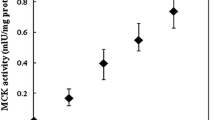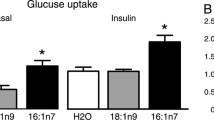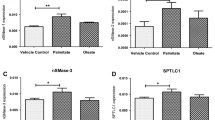Abstract
Insulin resistance in skeletal muscle is a feature associated with exposure to an excess of saturated fatty acids such as palmitate. Oleic acid has been shown to blunt palmitate-induced insulin resistance in muscle cells. However, there is no literature available regarding the effect of oleic acid on palmitate-induced insulin resistance in intact muscle. Therefore, this study investigated the effect of oleic acid on palmitate-induced insulin resistance in rat soleus muscle and its underlying mechanisms. For these purposes, oleic acid (1 mM) was administered for 12 h in the absence or presence of palmitate (2 mM). At the end of the experiment, plasmalemmal GLUT4, the phosphorylation of AS160 and Akt-2, and the total expression of these signaling proteins were examined. We found that treatment with palmitate for 12 h reduced insulin-stimulated GLUT4 translocation and the phosphorylation of AS160 and Akt-2. However, the administration of oleic acid fully restored insulin-stimulated GLUT4 translocation (P < 0.05), as well as AS160 and Akt-2 phosphorylation (P < 0.05) despite the continuous presence of palmitate. Wortmannin, an inhibitor of PI3-K, only slightly prevented the oleic acid-induced improvements in insulin-stimulated GLUT4 translocation, and AS160 phosphorylation. However, this treatment completely inhibited the oleic acid-induced improvement in insulin-stimulated Akt-2 phosphorylation. In contrast, the oleic acid-induced improvement in insulin signaling was not affected by compound C, an AMPK specific inhibitor. In conclusion, the results clearly indicate that oleic acid administration alleviates palmitate-induced insulin resistance by promoting GLUT4 translocation in muscle, at least in part, by activating the PI3K pathway.









Similar content being viewed by others
References
Alkhateeb H, Chabowski A, Glatz JF, Gurd B, Luiken JJ, Bonen A (2009) Restoring AS160 phosphorylation rescues skeletal muscle insulin resistance and fatty acid oxidation while not reducing intramuscular lipids. Am J Physiol Endocrinol Metab 297(5):E1056–E1066
Alkhateeb H, Chabowski A, Glatz JF, Luiken JF, Bonen A (2007) Two phases of palmitate-induced insulin resistance in skeletal muscle: impaired GLUT4 translocation is followed by a reduced GLUT4 intrinsic activity. Am J Physiol Endocrinol Metab 293(3):E783–E793
Alkhateeb H, Bonen A (2010) Thujone, a component of medicinal herbs, rescues palmitate-induced insulin resistance in skeletal muscle. Am J Physiol Regul Integr Comp Physiol 299(3):R804–R812
Alvim RO, Cheuhen MR, Machado SR, Sousa AG, Santos PC (2015) General aspects of muscle glucose uptake. An Acad Bras Cienc 87(1):351–368
Bruss MD, Arias EB, Lienhard GE, Cartee GD (2005) Increased phosphorylation of Akt substrate of 160 kDa (AS160) in rat skeletal muscle in response to insulin or contractile activity. Diabetes 54:41–50
Dimopoulos N, Watson M, Sakamoto K, Hundal HS (2006) Differential effects of palmitate and palmitoleate on insulin action and glucose utilization in rat L6 skeletal muscle cells. Biochem J 399(3):473–481
Fu Y, Luo L, Luo N, Zhu X, Garvey WT (2007) NR4A orphan nuclear receptors modulate insulin action and the glucose transport system: potential role in insulin resistance. J Biol Chem 282(43):31525–31533
Gao D, Griffiths HR, Bailey CJ (2009) Oleate protects against palmitate-induced insulin resistance in L6 myotubes. Br J Nutr 102(11):1557–1563
Griffin ME, Marcucci MJ, Cline GW, Bell K, Barucci N, Lee D et al (1999) Free fatty acid-induced insulin resistance is associated with activation of protein kinase C theta and alterations in the insulin signaling cascade. Diabetes 48(6):1270–1274
Henique C, Mansouri A, Fumey G, Lenoir V, Girard J, Bouillaud F et al (2010) Increased mitochondrial fatty acid oxidation is sufficient to protect skeletal muscle cells from palmitate-induced apoptosis. J Biol Chem 285(47):36818–36827
Højlund K, Mustard KJ, Staehr P, Hardie DG, Beck-Nielsen H, Richter EA et al (2004) AMPK activity and isoform protein expression are similar in muscle of obese subjects with and without type 2 diabetes. Am J Physiol Endocrinol Metab 286(2):E239–E244
Hommelberg PP, Plat J, Langen RC, Schols AM, Mensink RP (2009) Fatty acid-induced NF-κB activation and insulin resistance in skeletal muscle are chain length dependent. Am J Physiol Endocrinol Metab 296(1):E114–E120
Hommelberg PP, Plat J, Sparks LM, Schols AM, van Essen AL, Kelders MC et al (2011) Palmitate-induced skeletal muscle insulin resistance does not require NF-κB activation. Cell Mol Life Sci 68(7):1215–1225
Jing M, Cheruvu VK, Ismail-Beigi F (2008) Stimulation of glucose transport in response to activation of distinct AMPK signaling pathways. Am J Physiol Cell Physiol 295(5):C1071–C1082
Kang C, Lee H, Jung ES, Seyedian R, Jo M, Kim J et al (2012) Saffron (Crocus sativus L.) increases glucose uptake and insulin sensitivity in muscle cells via multipathway mechanisms. Food Chem 135(4):2350–2358
Karlsson HK, Zierath JR, Kane S, Krook A, Lienhard GE, Wallberg-Henriksson H (2005) Insulin-stimulated phosphorylation of the Akt substrate AS160 is impaired in skeletal muscle of type 2 diabetic subjects. Diabetes 54:1692–1697
Larance M, Ramm G, Stöckli J, van Dam EM, Winata S, Wasinger V et al (2005) Characterization of the role of the Rab GTPase-activating protein AS160 in insulin-regulated GLUT4 trafficking. J Biol Chem 280(45):37803–37813
Lee AD, Hansen PA, Holloszy JO (1995) Wortmannin inhibits insulin-stimulated but not contraction-stimulated glucose transport activity in skeletal muscle. FEBS Lett 361(1):51–54
Maria Z, Campolo AR, Lacombe VA (2015) Diabetes alters the expression and translocation of the insulin-sensitive glucose transporters 4 and 8 in the atria. PLoS One. https://doi.org/10.1371/journal.pone.0146033
McIntyre EA, Halse R, Yeaman SJ, Walker M (2004) Cultured muscle cells from insulin-resistant type 2 diabetes patients have impaired insulin, but normal 5-amino-4-imidazolecarboxamide riboside-stimulated, glucose uptake. J Clin Endocrinol Metab 89(7):3440–3448
Nandi A, Wang X, Accili D, Wolgemuth DJ (2010) The effect of insulin signaling on female reproductive function independent of adiposity and hyperglycemia. Endocrinology 151(4):1863–1871
Pinel A, Morio-Liondore B, Capel F (2014) n-3 Polyunsaturated fatty acids modulate metabolism of insulin-sensitive tissues: implication for the prevention of type 2 diabetes. J Physiol Biochem 70(2):647–658
Piro S, Maniscalchi ET, Monello A, Pandini G, Mascali LG, Rabuazzo AM et al (2010) Palmitate affects insulin receptor phosphorylation and intracellular insulin signal in a pancreatic alpha-cell line. Endocrinology 151(9):4197–4206
Sakamoto K, Holman GD (2008) Emerging role for AS160/TBC1D4 and TBC1D1 in the regulation of GLUT4 traffic. Am J Physiol Endocrinol Metab 295(1):E29–E37
Saltiel AR, Pessin JE (2003) Insulin signaling in microdomains of the plasma membrane. Traffic 4:711–716
Satoh T (2014) Molecular mechanisms for the regulation of insulin-stimulated glucose uptake by small guanosine triphosphatases in skeletal muscle and adipocytes. Int J Mol Sci 15(10):18677–18692
Sawada K, Kawabata K, Yamashita T, Kawasaki K, Yamamoto N, Ashida H (2012) Ameliorative effects of polyunsaturated fatty acids against palmitic acid-induced insulin resistance in L6 skeletalmuscle cells. Lipids Health Dis. https://doi.org/10.1186/1476-511X-11-36
Steinberg GR, Smith AC, Van Denderen BJ, Chen Z, Murthy S, Campbell DJ et al (2004) AMP-activated protein kinase is not down-regulated in human skeletal muscle of obese females. J Clin Endocrinol Metab 89(9):4575–4580
Thong FS, Bilan PJ, Klip A (2007) The Rab GTPase-activating protein AS160 integrates Akt, protein kinase and AMP-activated protein kinase signals regulating GLUT4 traffic. Diabetes 56(2):414–423
Treebak JT, Glund S, Deshmukh A, Klein DK, Long YC, Jensen TE et al (2006) AMPK-mediated AS160 phosphorylation in skeletal muscle is dependent on AMPK catalytic and regulatory subunits. Diabetes 55(7):2051–2058
Watson RT, Pessin JE (2007) GLUT4 translocation: the last 200 nanometers. Cell Signal 19(11):2209–2217
Xu PT, Song Z, Zhang WC, Jiao B, Yu ZB (2015) Impaired translocation of GLUT4 results in insulin resistance of atrophic soleus muscle. Biomed Res Int. https://doi.org/10.1155/2015/291987
Yuzefovych L, Wilson G, Rachek L (2010) Different effects of oleate vs. palmitate on mitochondrial function, apoptosis, and insulin signaling in L6 skeletal muscle cells: role of oxidative stress. Am J Physiol Endocrinol Metab 299(6):E1096–E1105
Zhou YT, Grayburn P, Karim A, Shimabukuro M, Higa M, Baetens D et al (2000) Lipotoxic heart disease in obese rats: implications for human obesity. Proc Natl Acad Sci U S A 97(4):1784–1789
Acknowledgements
The authors would like to thank Yarmouk University, Irbid, Jordan, for providing the required facilities and interdisciplinary research environment. We sincerely thank professor David J Dyck from University of Guelph, Ontario, Canada, for his help with the language editing of the manuscript.
Author information
Authors and Affiliations
Corresponding author
Rights and permissions
About this article
Cite this article
Alkhateeb, H., Qnais, E. Preventive effect of oleate on palmitate-induced insulin resistance in skeletal muscle and its mechanism of action. J Physiol Biochem 73, 605–612 (2017). https://doi.org/10.1007/s13105-017-0594-9
Received:
Accepted:
Published:
Issue Date:
DOI: https://doi.org/10.1007/s13105-017-0594-9




